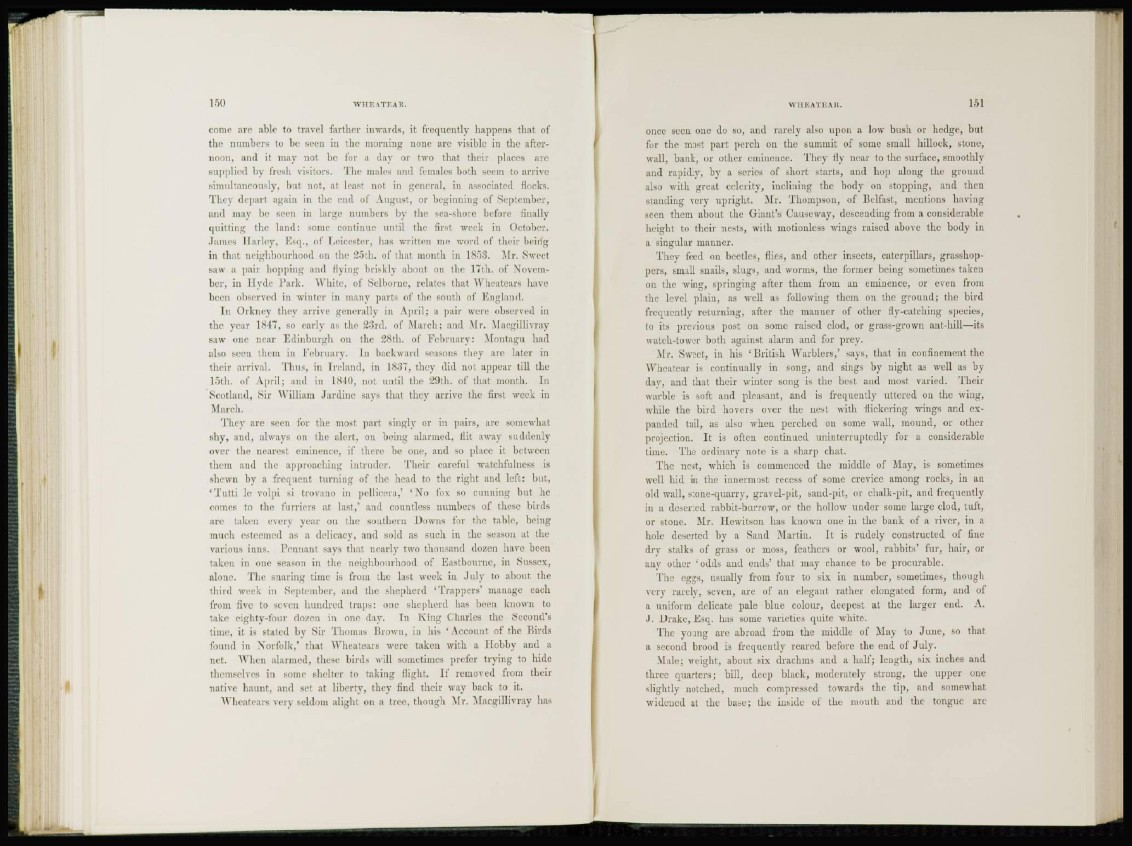
come are able to travel farther inwards, it frequently happens that of
the numbers to be seen in the morning none are visible in the afternoon,
and it may not be for a day or two that their places arc
supplied by fresh visitors. The males and females both seem to arrive
simultaneously, but not, at least not in general, in associated flocks.
They depart again in the end of August, or beginning of September,
and may be seen in large numbers by the sea-shore before finally
quitting the land: some continue until the first week in October,
.lames llarley, Esq., of Leicester, has written me word of their beiifg
in that neighbourhood on the 25th. of that month in 1853. Mr. Sweet
saw a pair hopping and flying briskly about on the 17th. of November,
in Hyde Lark. White, of Selborne, relates that Wheatears have
been observed in winter in many parts of the south of England.
In Orkney they arrive generally in April; a pair were observed in
the year 1847, so early as the 23rd. of March; and Mr. Maegillivray
saw one near Edinburgh on the 28th. of February: Montagu had
also seen them in February. In backward seasons they are later in
their arrival. Thus, in Ireland, in 1837, they did not appear till the
15th. of April; and in 1810, not until the 29th. of that month. In
Scotland, Sir William Jardine says that they arrive the first week in
March.
They are seen for the most part singly or in pairs, are somewhat
shy, and, always on the alert, on being alarmed, flit away suddenly
over the nearest eminence, if there be one, and so place it between
them and the approaching intruder. Their careful watchfulness is
shewn by a frequent turning of the head to the right and left: but,
' T u t t i le volpi si trovano in pellicera,' 'No fox so cunning but he
comes to the furriers at last,' and countless numbers of these birds
arc taken every year on the southern Downs for the table, being
much esteemed as a delicacy, and sold as such in the season at the
various inns. Pennant says that nearly two thousand dozen have been
taken in one season in the neighbourhood of Eastbourne, in Sussex,
alone. The snaring time is from the last week in July to about the
third week in September, and the shepherd 'Trappers' manage each
from five to seven hundred traps: one shepherd has been known to
take eighty-four dozen in one day. In fving Charles the Second's
time, it is stated by Sir Thomas Brown, in his 'Account of the Birds
found in Norfolk,' that Wheatears were taken with a Hobby and a
net. When alarmed, these birds will sometimes prefer trying to hide
themselves in some shelter to taking flight. If removed from their
native haunt, and set at liberty, they find their way back to it.
Wheatears very seldom alight on a tree, though Mr. Maegillivray has
once seen one do so, and rarely also upon a low bush or hedge, but
for the most part perch on the summit of some small hillock, stone,
wall, bank, or other eminence. They fly near to the surface, smoothly
and rapidly, by a series of short starts, and hop along the ground
also with great celerity, inclining the body on stopping, and then
standing very upright. Mr. Thompson, of Belfast, mentions having
seen them about the Giant's Causeway, descending from a considerable
height to their nests, with motionless wings raised above the body in
a singular manner.
They feed on beetles, flies, and other insects, caterpillars, grasshoppers,
sin ill snails, slugs, and worms, the former being sometimes taken
on the wing, springing after them from an eminence, or even from
the level plain, as well as following them on the ground; the bird
frequently returning, after the manner of other fly-catching species,
to its previous post on some raised clod, or grass-grown ant-hill—its
watch-tower both against alarm and for prey.
Mr. Sweet, in his 'British "Warblers,' says, that in confinement the
Wheal ear is continually in song, and sings by night as well as by
day, and that their winter song is the best and most varied. Their
warble is soft and pleasant, and is frequently uttered on the wing,
while the bird hovers over the nest with flickering wings and expanded
tail, as also when perched on some waU, mound, or other
projection. It is often continued uninterruptedly for a considerable
time. The ordinary note is a sharp chat.
The nest, which is commenced the middle of May, is sometimes
well hid in the innermost recess of some crevice among rocks, in an
old wall, stone-quarry, gravel-pit, sand-pit, or chalk-pit, and frequently
in a deserted rabbit-burrow, or the hollow under some large clod, tuft,
or stone. Mr. Hewitsou has known one in the bank of a river, in a
hole deserted by a Sand AI art in. It is rudely constructed of fine
dry stalks of grass or moss, feathers or wool, rabbits' fur, hair, or
any other 'odds and ends' that may chance to be procurable.
The eggs, usually from four to six. in number, sometimes, though
very rarely, seven, are of an elegant rather elongated form, and of
a uniform delicate pale blue colour, deepest at the larger end. A.
J. Drake, Esq. has some varieties quite white.
The young are abroad from the middle of May to June, so that
a second brood is frequently reared before the end of July.
Male; weight, about six drachms and a half; length, six inches and
three quarters; bill, deep black, moderately strong, the upper one
slightly notched, much compressed towards the tip, and somewhat
widened at the base; the inside of the mouth and the tongue arc